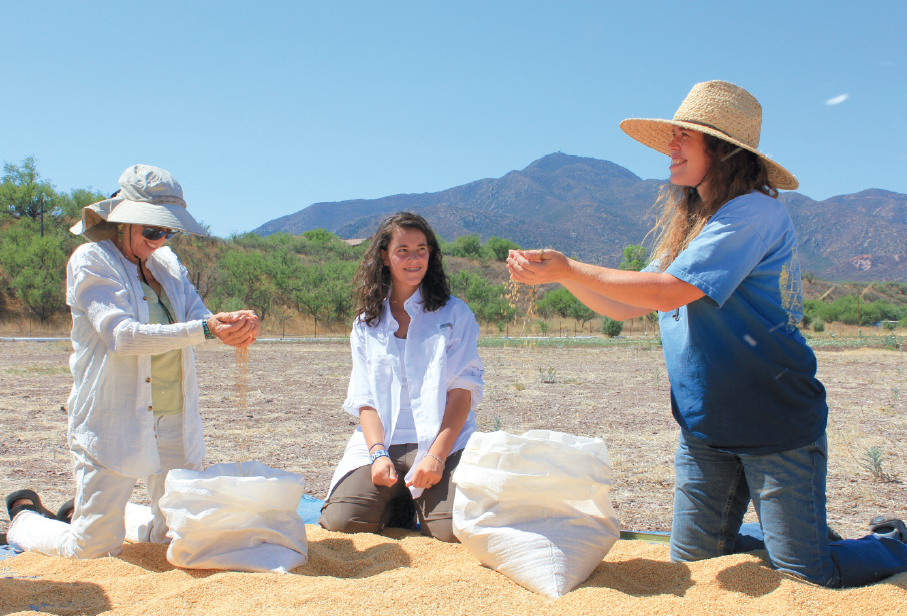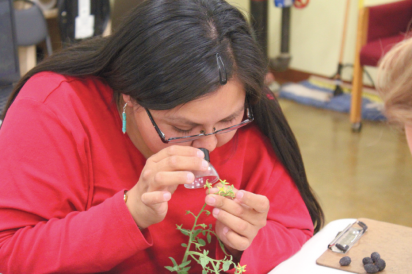Seed School: Germinating Hardy "Seed Citizens"
Beneath Tucson's bright desert sky, comfortably shaded by the solar cells of the Native Seeds/SEARCH Conservation Center's courtyard awnings, Bill McDorman quizzes his latest crop of students with a whisper of contagious awe: "What is a seed?" he asks.
The answers ring out free of hesitation. "Magic!" Justine Hernandez says. "A reflection of culture," someone else chimes in. "Technology." "An embryo." "A history book." Joy Hought rounds out the ideas with: "A spaceship!"
Hought is writing her Master's thesis on European plant breeding for sustainable agriculture. Hernandez, of Pima County Public Libraries, is gearing up to launch five seed lending programs across her corner of southern Arizona. Josh Banno and Oliver Savage–inspired do-it-yourselfers– roll "seed bombs" with compost and clay from their Tucson yards, then toss them into the urban desert landscape from their bikes. Sister Emmanuel was sent by her Episcopal order in Brewster, New York, to learn seed saving for their self-sustaining enterprise, Bluestone Farm. Aaron Cardona is breathing new life into his grandfather's farm in Sulphur Springs, Arizona. Veletta Canouts doesn't plan to plant a thing, but as an anthropologist working with Native American communities, hopes to deepen her understanding of seeds and their secrets.
For one week, this class of 22 students is gathered together for Seed School, a full-throttle educational experience offered periodically by McDorman, executive director, and Belle Star, deputy director of Tucson's Native Seeds/SEARCH (NS/S)–a seed bank and learning center dedicated to the preservation and promotion of the greater Southwest's agricultural heritage since 1983. Seed School's goals are to inspire and empower a diverse selection of new "seed citizens": passionate growers, inventive breeders and careful curators of the planet's tiny life-conducting jewels.
Orientation for a New Agriculture
After more than 30 years running his own seed companies (Garden City Seeds, High Altitude Gardens, Seeds Trust), an impassioned McDorman confides to his students that he has long been working to put the industry out of business– nonprofit seed banks like NS/S included.
"Let's shut this place down!" McDorman laughs, fist in the air. "For 10,000 years we never needed seed banks," he explains. His idea: If enough people learn to grow their own food again– and save seeds–we won't need such emergency measures.
Sometimes he takes the long and optimistic view. More often, he's focused on the practical and immediate food security concerns of the present.
"Now that we've mono-cropped the entire planet, we need to get back to our own agriculture," he argues. For this mission, the NS/S gene bank is invaluable. Before entering the seed vault, McDorman tells his students: "Let me show you one of the most amazing places on the Earth."
The seeds protected at NS/S's million-dollar conservation center were first gathered in the 1980s from across the American Southwest and northern Mexico in response to Native Americans struggling to locate the seeds needed to replant their traditional crops. Collected from more than 50 indigenous tribes, the 1,900 heirloom varieties stewarded by NS/S contain thousands of years of food-plant breeding history and biodiversity.
Over the course of the first few class sessions, McDorman combines his own research into the history of seeds with delightful stories gathered across a lifetime of seed-related experience. The result is something like a State of the Seed World Address–a detailed orientation to the rapidly changing seed situation around the planet.
In recent years a very few multinational corporations have bought up thousands of small seed companies, then discontinued production of many crop varieties to streamline their operations. McDorman explains that, according to the Center for Biodiversity, 96% of food crops available in 1903 are now extinct.
Genetically modified organisms (GMOs) created in laboratories by the transference of genetic material from one species to another also present an uncertain but potentially devastating threat to the future of seeds, while climate change, population growth and cultural erosion are all contributing their challenges as well.
Whereas, according to McDorman, America's land-grant universities were in part established for the express purpose of distributing free and regionally appropriate seeds to farmers, most of their research now supports industrial agriculture and the further privatization of what was once part of the public trust. "The knowledge we need now is moving outside of the university system," says McDorman.
Seed Sages Sow Wisdom and Wealth
Gary Paul Nabhan is sometimes called the father of the local foods movement, though he likes to see himself "more as the weird uncle." A conservation scientist and lecturer, he has authored many books on plants, food, natural and cultural history. He was recently named the endowed chair of the University of Arizona's Sustainable Food Systems Program in Southwest Borderlands Food and Water Security, and is one of the founders of NS/S.
Nabhan's home and land–Almuniya de los Zopilotes (Experimental Farm of the Vultures)–conveniently butts up against the NS/S Conservation Farm in Patagonia, AZ, allowing students to visit both locations on a single field trip. (Almuniya is a term from Moorish Spain describing private, experimental farms that strove to develop new crop varieties for the benefit of the country.) On a tour of the property Nabhan shows off curiosities like his rare Jack Beans from Baja Mexico–a plant with enormous prehistoric-looking seed pods. He also presents a thorough and engaging lecture on how to approach the gathering and documenting of seeds, a precursor to the students' task of collecting seeds from around the farm, while implementing Nabhan's tips.
Nabhan's homework assignment for the class underscores Seed School's emphasis on preserving biodiversity: By the end of their lives, students are expected to name their own variety of a plant, garden-bred or discovered in the wild, and report the achievement to Bill and Belle. "Otherwise you get an incomplete for Seed School," Nabhan jokes. Nabhan recognizes conservation as a function of consciousness. "If you don't name it and treasure it, how are you going to keep it around?" he asks.
While Seed School itself is a timely response to the privatization of the world's food supply and the subsequent loss of agricultural biodiversity, rather than bemoan the damage done the Seed School instructors are actively returning the power– and the plants–to the people. They are taking steps to breed new breeders, and encouraging them to develop open-pollinated varieties explicitly for the public domain.
Steve Peters, another of Seed School's instructors, was for 15 years the seed production manager at the New Mexico organic seed company Seeds of Change. He was hired to supervise this year's seed growout on the NS/S Conservation Farm in Patagonia. One of his contributions to Seed School is a daily dose of inspiring case studies in modern, private plant breeding, including short documentary films produced by Moria, his tech-savvy wife.
Peters sees American agriculture right now in the process "of rediscovering the message of biodiversity. We need to come back to our roots after having gone off in this other weird direction." he tells the class. "If we don't instill a seed ethic in our culture now, we're not going to make it."
Peters walks seed students, step-by-step, through his breeding experience of Shiraz Tall-top beets, a brand-new variety bred for great taste, classic root shape, vigorous greens and resistance to Rhizoctonia dry rot. This is neither a bio-tech invention nor an F1 hybrid with seeds that won't breed true to their kind, but an open-pollinated, available-for-seed saving regionally-adapted food plant.
Peters quotes world-renowned farmer-philosopher Wendell Berry's claim that "wealth is a deep understanding of the world you live in." By presenting students with fundamental knowledge and practical guidelines for learning not only to save seeds, but also to breed potentially significant food crops, Seed School is actively spreading the wealth.
Student Betsy Goodman from Nebraska agrees, "I feel like I've just been handed a gold nugget."
Ancient Seeds, Modern Learning
On the first evening of Seed School, students are divided into small groups and encouraged to list their "worst case scenario" fears regarding the program. Tuition is $700 for the week, including lunch, with scholarships available. Some students have flown significant distances, taking a full week from their lives to participate. Anxieties regarding the investments of time and money are foremost on many students' minds.
A second list of "best case scenario" outcomes reveals the students' general optimism: "We'll become seed geniuses," one small group says. "The falsity of scarcity will be revealed." "We'll all be better connected with our communities and ecosystems." "We'll get lots of free seeds."
While such activities function well as icebreakers– introducing the group to itself– they're also working at a deeper level to prime the students for a learning experience that will be unlike traditional classrooms. This is Belle Starr's bailiwick.
While McDorman is your science teacher, history instructor and sometimes far-out philosophy prof, Starr is your Seed School principal, homeroom teacher, guidance counselor, director of the cafeteria and–most importantly–curriculum specialist.
Seed School's pedagogy is based on Christopher Peck's "Whole Person Learning" scheme, a program developed for Permaculture education. Peck's program strives to increase learning by involving more than a narrow slice of the student's left brain hemisphere. A holistic learning cycle of "doing, feeling, watching and thinking" is meant to engage the entire learner.
The number of Seed School participants reporting that they were too excited to fall asleep after that first evening of activities is perhaps the greatest evidence that the approach works wonders.
"It is a dance," Starr says, "to keep people engaged and excited. My fear is the modern day malady 'death by PowerPoint.' I'm constantly challenging Bill and myself to stretch so we address many different learning styles."
". . . we need seeds more than they need us."
In a good example of "stacking functions in space and time" (a favorite Permaculture design strategy) students are encouraged to decompress, socialize and network in the Conservation Center courtyard after an intense day of classes by helping Seed Bank Director Chris Schmidt sort noxious weed seeds from enormous bags of Sonoran White wheat.
Schmidt explains that the seed cleaner at the Conservation Farm can only go so far in removing these tiny weed seeds from the wheat. Until access to a better cleaning device is found, human fingers offer the best technology.
Most importantly, students are running their fingers through an heirloom crop with great historical significance, as well as promise for the future–exactly the sort of agricultural evolution emphasized by the Seed School instructors.
Sonoran White wheat was first brought to the Southwest by Spanish missionaries in the 17th century. According to Schmidt, the local indigenous populations "had no winter staple crop, so it filled a gap in the growing season. And the flour tortilla was born." Schmidt further explains to the class that although the crop "has deep roots, is highly nutritious and drought tolerant, it fell out of use in the early 20th century."
This wheat seed is the foundation for a new regional grain system being explored in southern Arizona. Given the increasing desertification of croplands worldwide, a desert-adapted variety of wheat like the Sonoran White offers great potential for increasing food security around the world.
As Nabhan says when asked about the benefits of Seed School, "At this point in human history, we need seeds more than they need us. This is how we remain in contact with the cycles of growth and renewal that connect us with the natural world. We tend to think we're doing this to save the seeds, but I think ultimately we're doing this to save ourselves."







